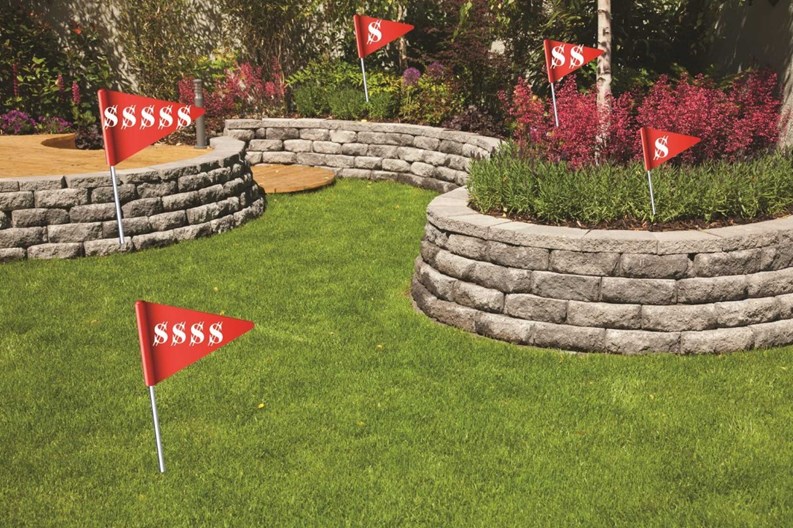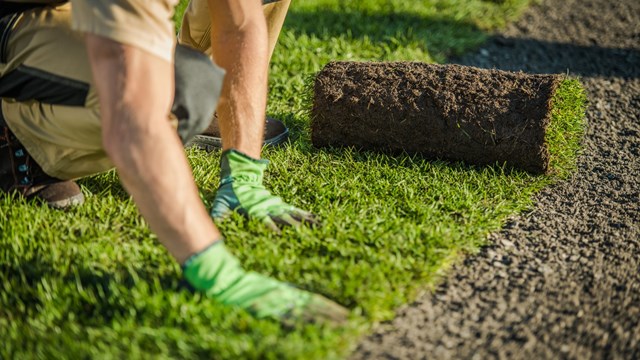These days, everybody is looking to save money—or dealing with the repercussions of not having saved enough in the past. And while lawns and shrubbery might seem like luxury items to some condo and co-op residents, aesthetics and curb appeal are crucial to a community’s longevity. In a depressed real estate market where every aspect of a property is scrutinized by buyers, a community’s financial health and its maintenance fees, as well as its physical attractiveness, are crucial selling points.
In some communities, maintenance costs can be higher than they need to be and often, parts of a landscape maintenance plan can be tweaked to save money. Lowering maintenance costs can help the community by easing the financial burden placed on residents and by making units more attractive to potential buyers. Following such a course isn’t a question of neglecting the lawn or letting the shrubs grow out of control, but rather, it’s as simple as making smarter choices on how to spend money on landscaping.
How It’s Spent
While it may seem that the spending for landscaping a community is not very significant, annual costs for such work can range from $5,000 to $600,000, depending upon the community. As much as 40 percent of a community’s annual maintenance budget could go to landscaping and snow removal, which often are done by the same company. Every contractor and each community differ from the next, but generally speaking, landscapers charge a certain percentage of their contracts based upon materials costs, labor and for emergency work.
Costs vary from job to job, which is why contractors differ on their estimates of average itemized percentages for such costs. Scott Scharaldi, New Jersey branch manager for Maryland-based landscaping firm the Brickman Group, says about 30 to 40 percent of an annual landscaping contract is comprised of labor costs, and 20 to 30 percent of the contract is for materials and equipment. Jody Shilan, president of the New Jersey Landscape Contractor’s Association and president of Jody Shilan Designs, LLC in Wyckoff, pegs such costs at 70 percent for regular maintenance, 20 percent for repair of damages, and 10 percent for seasonal planting. Some contractors also now are charging customers for fuel costs, which have risen as much as 10 percent for some companies.
Usually, landscapers bill communities at an annual contracted rate for the season, which runs from April to November. In some communities, costs for materials and plantings can be quite onerous, with mulching sometimes accounting for 30 to 40 percent of a landscape renovation project’s overall price. When considering where a community could save money, it helps to have a good plan from the start. A community’s landscaping plan always depends upon the long-term maintenance plan, and if parts of that plan are out of whack, the community could be spending more than is necessary.
Such excess spending could be due to the contractor’s lack of experience, such as when more maintenance is contracted than is needed. Or it could be the fault of the board, which chose to spend more than is needed on such things as annual flowers and regular maintenance visits. Sitting down with the landscaper and scrutinizing the community’s annual contract could reveal that some of these costs can be pared without sacrificing the beauty of the grounds.
The biggest way for associations to trim their landscaping materials costs is by properly planning out the landscape.
“You should account for mature sizes of plants and not overplant, as is often done. People want the place to look full and lush right away, and in five years they are ripping out half of it,” Shilan says. “By selecting the right plant materials, you can accomplish this. Using plants that mature to an appropriate height will save money in the long-term.”
Less Can Be More
Because many communities now need to cut back maintenance costs wherever possible, some are changing how they add color to their grounds. Instead of spending money on plants and bulbs that usually won’t last more than a season, some boards are changing their flower planting schemes from annual flowers to perennials. Doing so removes most of the recurring cost of flowers, because perennial flowers and ornamental grasses spread and flourish from year to year, and usually needn’t be replaced.
Annual flowers are often changed out three times a season—beginning with spring bulbs like tulips and daffodils, followed by colorful annuals planted in summer, and ending with fall plantings such as mums and kale. In addition to the always-rising costs for such plants, it takes a lot of laboring hours to plant and then dig up bulbs, and then replace them with summer annuals which later are unearthed, followed by planting fall flowers. Removing the need for annuals can provide big savings.
“You can go from spending $15 to $20 per square foot with annuals, to a one-time expense of $7 to $8 per square foot,” Scharaldi says.
For those communities that don’t want to lose all of the beauty provided by annual flowers, re-envisioning the overall look of the landscape might provide an easy compromise. Devising a new plan for using those annuals, in order to provide greater visual impact for less money, could be the solution.
“To reduce costs for seasonal flowers, you can put a lot of the color at the main entrance and forgo some of the other areas,” Shilan says. “In terms of getting attention, it’s always nice to have color in smaller areas.”
Rather than cutting back on planting annuals, some communities will try to lower the amount they pay for them by taking that portion of a landscaper’s annual contract and bidding it out to several companies. Doing so could get them a lower price for the work, without compromising the natural beauty of the place. Other communities try to cut back on seemingly fixed costs, like mulch for flowerbeds. But it’s a fine line to edge.
“It’s tough to cut in this industry. If I don’t put much down, the trees look terrible, and the weeds start to grow,” says Michael Branch, CEO of Livingston-based DuBrow's Nurseries Inc.
Who Decides?
To save money on landscaping, some communities have more of the work done by employees or residents. Some will have residents cut their own grass and only have common areas maintained by professionals. Taking this course could result in a less than uniform appearance to the greenery. For example, while Mr. Smith might like to keep his lawn practically putting green short, his next door neighbor could choose a longer, more unkempt look for his grass.
A community also could choose to have the landscaper cut the grass fewer times per year, which could bring a small savings. Making this move depends not only upon what residents care most about in the appearance of their greenery, it also depends upon how often the grass is fertilized and if it has an irrigation system. A lawn with an irrigation system will grow faster than a lawn without irrigation, so it’s easier to get away with cutting the grass less often when the lawn isn’t irrigated.
Cutting the grass less won’t necessarily bring a great savings. Usually, landscapers cut a client’s lawn an average of 28 times a year. Many companies wouldn’t recommend reducing the number of lawn mowings more than about four times per season. If it’s a dry summer they might reduce the number of lawn cuts to two times per month, rather than weekly.
Residents in some communities are less particular in how their lawns appear, and don’t mind what others would say is an out of control look. Some will have the grass maintained at 4 inches high during drought conditions, and as low as 3 inches in winter. Others will allow large areas of turf to grow into a meadow look, with the grass 8 inches to a foot high.
Redesigning the landscape so it has simpler lines also could save money.
“By making flowerbed lines simpler, it’s easy to maintain,” Shilan says, noting that having fewer small, odd-shaped patches of grass requires less work. “Design the landscape in such a way that it can be maintained faster.”
In some cases, having maintenance tasks done properly could save a small bundle. Landscapers vary in their knowledge and abilities, and not all have the expertise to do every task right. Some landscapers think every bush is maintained the same, but that approach can be costly and harmful to some plants.
Each plant has its own natural growth habit—some are meant to be hedges, such as yews, while others, such as azaleas, are meant to look more natural. While an upright yew needs regular pruning to look right, pruning an azalea or rhododendron—which should not look like a hedge or ball—should require less work. In fact, pruning such plants wrongly can lead to them being more susceptible to insects and disease.
Don’t Over-Prune
“Over-pruning trees and shrubs instead of allowing them to grow naturally takes a lot of time and is expensive,” Shilan says. ”If you select the right plants to begin with, you’ll be able to let the plants grow together into masses rather than pruning them and keeping them separate.”
Forsythia is a plant that should be placed smartly, for example. If it’s planted near a building it will be problematic, because it grows quickly and needs lots of pruning in such a placement. Such a bush is better used when it is placed as a boundary barrier.
Trying to cut back spending in the wrong ways could end up costing the community more money, instead of saving cash. Landscapers say it’s foolish to cut back on feeding the lawns and shrubs. Properly maintaining a shrub will allow it to provide the benefit for which it was intended, and could help it to live for decades. Failing to do so could create costly problems that will need to be addressed to get the lawn, bush or tree back into healthy shape. Or worse, it might mean the plant dies and needs to be replaced.
Most landscapers advise against scrimping on plantings near the property’s main entrance, or any spot that is a main focal point. Maintaining curb appeal with attractive vegetation is as essential as keeping the trim painted and looking sharp.
Freelance writer Jonathan Barnes is a regular contributor to The New Jersey Cooperator and other publications.







Leave a Comment